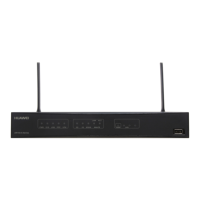4.8.2 Example for Configuring Local Flow Mirroring
With the local flow mirroring function, the AR150/200 can monitor the packets with the same
characteristics.
Networking Requirements
As shown in Figure 4-8, an enterprise's R&D department connects to the Router through
Ethernet0/0/0. A server with the monitoring software installed is connected to Ethernet0/0/1 on
the Router to analyze the captured packets. The enterprise needs to monitor all the IPv4 packets
sent from host 192.168.1.10/24 in the R&D department.
Figure 4-8 Local flow mirroring network
Eth0/0/0 Eth0/0/1
Router
Server
HostA
192.168.1.10/24
R&D
department
Configuration Roadmap
The configuration roadmap is as follows:
1. Configure Ethernet0/0/1 as the observing interface.
2. Create a traffic classifier to match the IPv4 packets with the source IP address
192.168.1.10/24.
3. Create a traffic behavior and bind it to the local flow mirroring action.
4. Create a traffic policy and bind it to the traffic classifier and traffic behavior.
5. Apply the traffic policy to Ethernet0/0/0.
Data Preparation
To complete the configuration, you need the following data:
l Type and number of the observing interface
l Type and number of the mirrored interface
l Observing interface index, 1
l Traffic classifier, c1
l Traffic behavior, b1
l Traffic policy, p1
Huawei AR150&200 Series Enterprise Routers
Configuration Guide - Device Management 4 Mirroring Configuration
Issue 02 (2012-03-30) Huawei Proprietary and Confidential
Copyright © Huawei Technologies Co., Ltd.
80

